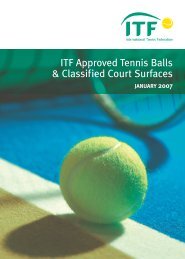Tennis Book 2010_Layout 1 - TIA UK
Tennis Book 2010_Layout 1 - TIA UK
Tennis Book 2010_Layout 1 - TIA UK
Create successful ePaper yourself
Turn your PDF publications into a flip-book with our unique Google optimized e-Paper software.
over the last half century, have embraced more overt<br />
commercialism. That doesn’t mean that Wimbledon hasn’t, they<br />
have just managed to retain more of the atmosphere of years<br />
gone by!<br />
Looking back at the four championships, Wimbledon was the<br />
first to establish itself in 1877, the US followed in 1881, the<br />
French a decade later in 1891 and the Australian at the turn of<br />
the century in 1905. However as far as the calendar is<br />
concerned, the order is very different with Australia played in<br />
mid-January, followed by France late May-early June and then<br />
Wimbledon late June-early July with the US bringing up the<br />
rear in late August-early September.<br />
Initially all four were very much national events and it wasn’t<br />
really until the twenties that the sport could be said to have<br />
become more international and start establishing themselves as<br />
the ones to win.<br />
Briefly, this is how they came to be and develop into the major<br />
championships they are now, namely the backbone of tennis.<br />
The oldest main show court of the four Grand Slams, the<br />
Centre Court at Wimbledon with its own sliding ‘umbrella’<br />
style roof unfurled in 2009. Picture Fotosports International.<br />
The Championships, Wimbledon<br />
Wimbledon is the only one of the four to have retained its roots<br />
in the suburb where it was ‘conceived’ though it did have to<br />
move in 1922 from Worple Road to a new site virtually over the<br />
hill in Church Road. There it has retained the grass surface<br />
which the game was originally played on, and is now the only<br />
grand slam to have retained its surface throughout its history<br />
while developing a modern venue which is held in high esteem<br />
by players, officials and spectators. Initially The Championships<br />
was only open to men with the women being incorporated in<br />
1844 as the game grew in popularity. The only event held in<br />
1877 was the Gentlemen’s Singles, which was won by Spencer<br />
Gore, an old Harrovian rackets player, from a field of 22. About<br />
200 spectators paid one shilling each to watch that final.<br />
Interestingly the Centre Court label derives from those early<br />
days as the main court was located in the middle of all the<br />
other courts. The label for the main show court was retained<br />
when the club moved even though in Church Road, it no longer<br />
was at the centre of the activities. This was eventually corrected<br />
9<br />
in 1980 when four new courts were introduced on the north<br />
side and further emphasised when the new No1 Court was<br />
commissioned into use in 1997.<br />
In 1913 the tournament was designated ‘The World<br />
Championships on Grass Courts’, a term which was dropped in<br />
1922.<br />
Of the four majors, Wimbledon is the only one run by a private<br />
members’ club though the actual organisation of The<br />
Championships, is shared between the All England Lawn<br />
<strong>Tennis</strong> & Croquet Club and The Lawn <strong>Tennis</strong> Association who<br />
benefit from a 1934 financial arrangement whereby they receive<br />
any financial ‘surplus’ from Championships. This agreement<br />
was extended in 1993 with a new ‘Heads of terms’ to come into<br />
operation in 2013.<br />
The US Open<br />
The US Open, which we associate with Flushing Meadows,<br />
New York, was first held at The Casino in Newport in August<br />
1881 and was staged there every year until 1915 when it moved<br />
to the West Side <strong>Tennis</strong> Club in Forest Hills, New York, for a<br />
three year stint. The event, then known as the US<br />
Championships, was restricted to members of clubs affiliated to<br />
the United States National Lawn <strong>Tennis</strong> Association and this<br />
rule applied until 1970 when it became the US Open.<br />
In 1921 it moved yet again for another three year period, to the<br />
Germantown Cricket Club in Philadelphia in a short lived<br />
attempt to rotate the event around the country. At that time<br />
Philadelphia was the home of the women’s championships<br />
which had been inaugurated in 1887. This was then switched to<br />
Forest Hills to fill the void left by the men! On completion of a<br />
new 14,000 seater stadium at Forest Hills, the men moved back<br />
and the two events were amalgamated in 1923.<br />
Like Wimbledon, the event was played on grass until 1974<br />
when the governing body decided to experiment with ‘Har-Tru’,<br />
a green clay surface. That experiment lasted just a few years<br />
and in 1978 was moved to the converted Louis Armstrong<br />
Stadium at the 1964 World Fair site at Flushing Meadows in<br />
the Queen’s district of New York where it has now firmly<br />
established itself with Decoturf hard courts replacing clay.<br />
Interestingly Jimmy Connors set a record by becoming the only<br />
player to win the US title on three different surfaces and Chris<br />
Evert is the only player to have won the US title on clay! The<br />
complex, which was named The Billie Jean King National<br />
<strong>Tennis</strong> Center at Corona Park - Flushing Meadows is a public<br />
facility when not hosting the US Open. It is also the USTA’s<br />
Eastern region training centre and can boast the largest tennis<br />
show court in the world seating 23,000, which has been named<br />
after Arthur Ashe.<br />
The French Open<br />
Like its American counterpart, the French when first played in<br />
1891 was restricted to their national players only opening its<br />
doors to foreign players in 1925, no doubt as a result of the











